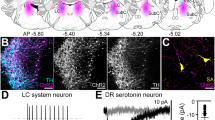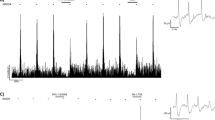Abstract
Several lines of evidence suggest that striatal cholinergic inter-neurones receive an excitatory input from the cerebral cortex which utilizes an excitatory amino acid, L-glutamate or L-aspartate, as its neurotransmitter. Cortical ablation reduces striatal high-affinity glutamate uptake1,2 and concomitantly decreases acetylcholine turnover3. The destruction of cholinergic, as well as other, neurones of the striatum by the rigid glutamate analogue kainic acid seems to require a functional excitatory amino acid innervation4,5. Furthermore, electron microscopic studies6 suggest the existence of a cortical input to the aspiny dendrites of neurones morphologically similar to the presumed striatal cholinergic interneurones7,8. The recent discovery of preferential antagonists of amino acid-induced excitation in the vertebrate central nervous system has led to the classification of excitatory amino acid receptors into three subtypes: the N-methyl-D-aspartate (NMDA), the quisqnalate-and the kainate-preferring receptors9. We have now attempted to characterize the receptor(s) mediating the excitatory amino acid influence on striatal cholinergic neurones by investigating the effects of specific excitatory amino acid receptor agonists and antagonists on the release of 3H-acetylcholine from slices of the rat corpus striatum. We find that excitatory amino acid analogues evoke a tetrodotoxin-sensitive release of 3H-acetylcholine from rat striatal slices superfused in Mg2+-free medium, NMDA and ibotenate being the most potent and kainate and quisqualate the least potent. This effect is antagonized by Mg2+ and by (−)2-amino-7-phosphonoheptanoate (−APHept) and (±)2-amino-5-phosphonopentanoate (±APPent) but not by glutamic acid diethyl ester (GDEE). These data suggest the involvement of a NMDA-type receptor in the excitatory amino acid influence on striatal acetylcholine release.
This is a preview of subscription content, access via your institution
Access options
Subscribe to this journal
Receive 51 print issues and online access
$199.00 per year
only $3.90 per issue
Buy this article
- Purchase on Springer Link
- Instant access to full article PDF
Prices may be subject to local taxes which are calculated during checkout
Similar content being viewed by others
References
McGeer, P. L., McGeer, E. G., Scherer, U. & Singh, K. Brain Res. 128, 369–373 (1977).
Divac, I., Fonnum, F. & Storm-Mathisen, J. Nature 266, 377–378 (1977).
Wood, P. L., Moroni, F., Cheney, D. L. & Cheney, E. Neurosci. Lett. 12, 349–354 (1979).
McGeer, E. G., McGeer, P. L. & Singh, K. Brain Res. 139, 381–383 (1978).
Biziere, K. & Coyle, J. T. Neurosci. Lett. 8, 303–310 (1978).
Hassler, R., Chung, J. W., Rinne, U. & Wagner, A. Expl Brain Res. 31, 67–80 (1978).
Lehmann, J. & Fibiger, H. C. Life Sci. 25, 1939–1947 (1979).
Kimura, H., McGeer, P. L., Peng, F. & McGeer, E. G. Science 208, 1057–1059 (1980).
Watkins, J. C. in Glutamate: Transmitter in the Central Nervous System (eds Roberts, P. J., Storm-Mathisen, J. & Johnston, G. A. R.) 1–24 (Wiley, Chichester, 1981).
Watkins, J. C., Davies, J., Evans, R. H., Francis, A. A. & Jones, A. W. in Glutamate as a Neurotransmitter (eds Di Chiara, G. & Gessa, G. L.) 263–273 (Raven, New York, 1981).
Perkins, M. N., Stone, T. W., Collins, J. F. & Curry, K. Neurosci. Lett. 23, 333–336 (1981).
Luini, A., Goldberg, O. & Teichberg, V. I. Proc. natn. Acad. Sci. U.S.A. 78, 3250–3254 (1981).
Author information
Authors and Affiliations
Rights and permissions
About this article
Cite this article
Scatton, B., Lehmann, J. N-methyl-D-aspartate-type receptors mediate striatal 3H-acetylcholine release evoked by excitatory amino acids. Nature 297, 422–424 (1982). https://doi.org/10.1038/297422a0
Received:
Accepted:
Issue Date:
DOI: https://doi.org/10.1038/297422a0
This article is cited by
-
Dissociating scopolamine-induced disrupted and persistent latent inhibition: stage-dependent effects of glycine and physostigmine
Psychopharmacology (2010)
-
The vesicular glutamate transporter VGLUT3 synergizes striatal acetylcholine tone
Nature Neuroscience (2008)
-
Role of dopaminergic neuronal system in dizocilpine-induced acetylcholine release in the rat brain
Journal of Neural Transmission (1996)
-
Receptor binding of glutamate in the striatum of rats differing in learning capacity
Neuroscience and Behavioral Physiology (1995)
-
Alterations in striatal acetylcholine overflow by cocaine, morphine, and MK-801: relationship to locomotor output
Psychopharmacology (1994)
Comments
By submitting a comment you agree to abide by our Terms and Community Guidelines. If you find something abusive or that does not comply with our terms or guidelines please flag it as inappropriate.



